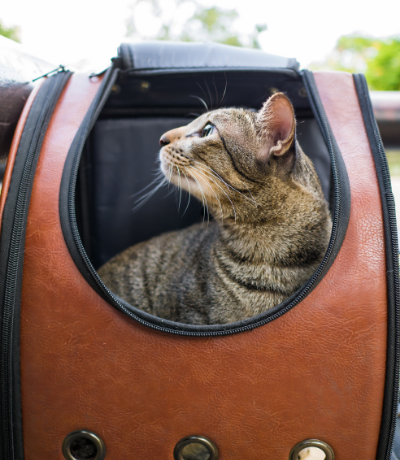How to Travel With Pets
If you can’t imagine leaving your beloved fur baby behind when you travel, this article is for you. Here’s what you need to know about how to travel pets.
11 March 2022
For many people, their pets are a part of the family. Making plans to travel is hard for them because they have to figure out what to do with their pets.
Will they stay with a friend, spend time alone in a kennel, or have a pet sitter?
If you can’t imagine leaving your pet behind, the truth is that you may be able to take them with you.
Here’s what you need to know if you want to travel with pets.

What modes of travel allow pets?
For the pet owners/parents who don’t want to leave their fur babies at home when they travel, here’s the scoop on each of the modes of transportation.
Planes
Other than service dogs, which we’ll talk about in a minute, dogs and cats can only board the plane with you if they are small enough to fit under the seat in front of you inside their carrier. On the plus side, this is the most convenient and worry-free choice for smaller pets.
On planes, your pet can travel in one of three ways:
- In hand luggage in the cabin with you (depending on the pet’s size)
- As excess baggage in the cargo hold of the aircraft, or
- In the hold (as cargo) of the aircraft
The last two in the list above sound similar but there is a slight difference. A pet inside an approved travel crate can be checked as excess baggage, essentially as a piece of luggage. They can also travel as manifested cargo on certain routes or on international flights.
The airlines are supposed to maintain temperature controls when excess baggage consists of a live animal. While personnel have basic training to handle live animals, the level of attention is constricted by time (and willingness). In addition, live animals are supposed to be the last to go on the plane and the first to come off, but that’s not always a guaranteed process.
Passenger demand for lower cost alternatives and the ability to travel with their pet has not resulted in significant policy changes for airlines. For most pet owners, the risk is too great to allow their beloved pet to travel in the cargo hold.
Pro tip: Some pet owners are turning to professional pet relocation service providers to handle the logistics of transporting a pet for a long trip.
Trains
As you might expect, the rules for train travel with a pet is highly dependent on the line. For example, Amtrak has a program for transporting small dogs and cats similar to the airlines
There are plenty of rules you’ll need to know:
- Not all routes are pet-friendly
- Pets have to stay in their carriers
- If they don’t fit under your seat (coach class only), they’re checked into the cargo
- Pets have to be in approved carriers
- You must include your pet when you make a reservation
- You must check in your pet and provide the required paperwork
The rules for train travel with a pet in non US countries are similar, but you’ll need to do some significant research before you go. Costs vary as well.
Automobiles
You can always travel with your pet in your own vehicle, and pets are allowed in rental vehicles. Most major rental car companies welcome four-legged passengers without an extra fee. They will, however, charge a cleaning fee if the vehicle is not returned in relatively good condition.
See the pet-friendly car rental agencies according to the BringFido website
Pro tip: Bring a seat cover designed for pets.
Ships
The only cruise line with facilities for your dog or cat is the post Queen Mary 2 ocean liner. The ship holds the long-standing tradition of being pet-friendly.
Service dogs versus emotional support dogs
The rules for flying with service animals have changed. Prior to January 2021, some pet owners got around restrictions against traveling with their pets by having them registered as emotional support animals.
In December 2020, the US Department of Transportation revised the Air Carrier Access Act, which rules how airlines must accommodate passengers. The changes included:
- No longer allowing emotional support animals to qualify as service animals
- Narrowing the definition of a service animal to only include dogs
- Allowing airlines to require passengers to submit paperwork before boarding with a service dog
Essentially, unless your dog is a trained service animal with the paperwork to prove it, they can’t fly in the cabin.
What to expect when traveling with a pet
If you’re traveling on commercial or public transportation with your pet, you can expect to experience the following:
- Increased scrutiny – airlines have cracked down on dogs being too big for carry-ons since the pandemic and you may face increased scrutiny through security and before boarding as well as in flight.
- Extra paperwork and fees – some airlines require you to check in at the airport and show a list of paperwork and identification.
- Varying rules by airline – some airlines have weight limits for pets; others don’t. Some charge extra fees; others don’t.
- Some breeds of cats and dogs cannot fly at all.
You’ll need to carefully research the carrier’s rules and follow them closely.
What vets want you to know
It may sound counterintuitive but you should never sedate a pet for air travel.
Medical research has taught veterinarians and pet owners this is not a good idea. Sedation puts the brain to sleep and this means muscles too. If your pet is traveling in the cargo hold or even under the seat in front of you, they won’t be able to maintain their balance, which can cause your pet confusion, anxiety, and possible injuries.
Sedatives also reduce the heart rate, respiration, and body temperature. If your pet is in the cargo hold, or has a snub nose or respiratory issues, this could be deadly. In fact, most airlines won’t even accept a sedated pet.
Alternatives to sedation include herbal stress relievers like lavender, chamomile, and valerian or CBD oil. Veterinarians recommend practicing with these remedies before you travel to see what works best for your pet.
Resources for pet owners who want to travel with their pets
Here are some resources you can use to learn how to travel with pets:
- BringFido is a website that helps pet owners find destinations, hotels, activities, and events that accept dogs.
- These websites: Rover, TrustedHouseSitters, and Nomador help you find pet sitters who can check in on your pet or live in your house while you travel.
Related topics
- If you’re curious, here’s how travel insurance covers pets.
- You can also read what’s covered with travel insurance.
Damian Tysdal is the founder of CoverTrip, and is a licensed agent for travel insurance (MA 1883287). He believes travel insurance should be easier to understand, and started the first travel insurance blog in 2006.
